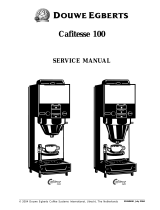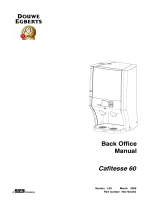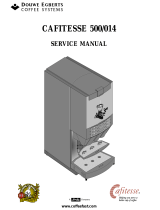Page is loading ...

Service Manual
Aeris
Thermal Cycler
Version 1.0 Publication Time August, 2009Copyright © 2013 Esco Micro Pte.Ltd. All rights reserved.
Thank you for purchasing the Esco Aeris Thermal Cycler.
Please read this manual thoroughly to familiarize yourself with
the many unique features and exciting innovations we have
built into cycler. You can view this manual online at
www.escoglobal.com, where you can find many other
resources to help you enjoy many years of productive and
safe use of your Esco equipment.

Chapter 1. Introduction
1.1 Products covered
This manual is applicable and specific to the following ESCO products:-
Aeris Thermal Cycler Aeris-MB with following blocks
Rated voltage (V) 96 wells
gradient
block
30 x 0.5ml +
48 x 0.2ml
mix block
384 wells
gradient
block
48 x 0.2ml x2
dual block
4 In Situ
Slides
100-240V, AC,
50/60Hz
AERIS-
BG096
AERIS-
B4830
AERIS-
BG384
AERIS-
BD048
AERIS-
B4076
1.2 Basic product information
1.2.1 QUICK VIEW

No. Name Description Note
1 Block With hot lid, heat sink and heating&
cooling system.
Five interchangeable blocks
are available for different
requirements.
2 LCD Screen
Display protocol, conditions and
other information during setting and
running.
6.5'' Color LCD Touch Screen
3 Keyboard For setting and controlling.
4 Ventilation vent Blow heat air out through
ventilation vent.
-Don’t block off ventilation
vent
5 USB interface Data transfer between USB and
equipment through USB interface -
6 Hot lid knob Adjust the height of the Knob
Turn the knob counter-
clockwise before closing the
lid. Note that the knob can be
tightened by turning it
clockwise, and can be
loosened by turning counter-
clockwise.
7 Unlocking Device Loose the hot lid knob
If hear click sound at the
beginning of turning the knob
clockwise and counter
clockwise, press the
unlocking device and turn the
knob counter-clockwise for
two rounds to loose the knob
8 RJ45 interface For PC control and software - Up to 30 Aeris thermal

upgrades cyclers can be connected and
controlled by normal
computer through RJ45
interface.
9 Power Switch Turn the equipment ON/OFF. -
10 Power Socket Connect power supply. -
11 Fuse Socket Install fuse in the socket to protect
equipment from over-current.
The fuse specifications are as
follows: 250V 8A, 5×20. Fuse
should be replaced by one
that complies with these
specifications.
1.2.2 Installing your instrument
Install and Remove the block as follows:
1.2.2.1 Installation:
• Place the block (1) into the housing well (2) and
push it slowly forwards until a connection between
the block socket and the main unit’s connection
plug (3) is achieved.
• Press the locking handle (4) downwards, the block
will move forward automatically until you hear the
click sound, which means the block is installed
successfully.
• Do not force!
1.2.2.2 Removing the Block
• Turn off the power supply.
• Uplift the locking handle (4), the block will move
backward a bit.
• Pull the locking handle to move block gently
towards the rear of the main body.
• Remove the block from the main body.
4
Note: • Turn off the power supply before installing block.
• When installing the block, pay close attention to pushing the block slowly and gently ; or the
main unit’s connecting plug may be damaged.
• When uninstalling the block, please pull the block from the block bath gently. Do not tilt the
block or the connection plug may break.
2
1
4
3

1.2.3 Technical specification summary table
General Specifications, Aeris Thermal Cycler
Block Code
AERIS
-
BG086
AERIS
-
B4830
AERIS
-
BG384
AERIS
-
BG384
AERIS
-
B4076
Sample Capacity
96 × 0.2ml 48 × 0.2ml + 30
× 0.5ml 384 wells 48 × 0.2ml + 48
× 0.2ml 4 slides
Applied
Consumables
0.2ml tubes
96 micro plate
12 x 8 strips
8 x 12 strips
0.2 ml tubes
0.5 ml tubes
4 x 12 strips
384 micro
plate
0.2ml tubes
6 x 8 strips
4 slides in situ
plate
Temperature
Range 4ºC ~ 105ºC
Max. Heating
Rate 4.0ºC / sec 2.8ºC / sec 2.8ºC / sec 4.0ºC / sec 1.8ºC / sec
Max. Cooling
Rate 4.0ºC / sec 2.8ºC / sec 2.8ºC / sec 4.0ºC / sec 1.8ºC / sec
Temperature
Uniformity ≤0.2ºC
Temperature
Accuracy ≤0.1ºC below 50 ºC
Max. Gradient
30ºC - 30ºC - -
Min. Gradient
1ºC - 1ºC - -
Hot Lid Temp.
range 30ºC ~ 110ºC
Temp. Control
Mode Block mode or Tube mode
Display
6.5” Color LCD Touch Screen
Instrument
Memory Up to 250 programs, unlimited with USB flash drive
PC Interface
RJ45 & USB port
Dimensions
(W x D x H) 306mm x 386mm x 295mm (WxLxH)
Weight (kg)
10
Power Supply
100-240 V / 50-60 Hz 600W
Fuse
250V 8A ø5 × 20
Warranty
3 years on main body, 2 years on blocks
1.3 Security Notes
i. Turn the power OFF and unplug the power cord before performing any procedure.
ii. Please read all the instructions thoroughly before maintenance. Always follow this
service manual. Keep this service manual well for future reference and review it as
necessary.
iii. Engineers must inspect and ensure operation of the equipment is completely back to
normal after maintenance.

1.4 Guidance
Pay attention on the following before hand.
i. Investigate :-
Situation of the equipment as operating
Previous maintenance record
Symptom of the failure
Hardware environment
Structure of the equipment
Years of the equipment be used
ii. Check power supply.
iii. Check installation of the equipment.
iv. Clean internal of the equipment to eliminate failures caused by dust, dirt, redundant
solder, welding oil.
v. Read all the instructions thoroughly before maintenance to ensure full understanding.
1.5 Maintenance tools
• Wire-stripping pliers, wire stripper
• Torque screwdriver Φ3
• Word screwdriver Φ2
• Cross screwdriver Φ3
• Sharp nose pliers, diagonal cutting nippers
• Pen knife
• Tweezers
• Multimeter

Besides, a multi-channel temperature acquisition device is needed for temperature uniformity and
accuracy testing.
Chapter 2 Service Procedures
2.1 Assemble and disassemble the main body
2.1.1 Assemble procedure
• Assemble the PCB board, power supply and fan with the stainless steel stand.
Put the whole part in the bottom casing and make sure the part is fastened by the
buckle of the bottom casing. Refer to Fig. 1
Fig. 1
• Tighten the four screws to fix the rubber feet with bottom casing. Refer to Fig. 2
Fig 2
2.1.2 Disassemble procedure
• Remove the screws as showed in the red square. Take down the left and right
board. Refer to Fig 3, and then you can see the whole main body structure
without the cover(Fig 4)
Fig 3

Fig 4
• Unplug all the connectors. Remove the screws in the interface (connector) board.
As Fig.4 and 5
• Remove the screws as Fig 5, and take out the old fan and replace a new fan
Fig 5 Fig 6
Notes Please note the air flow direction of the fan and the polarity of the connection wire when
replacing the fans. Please mark them to avoid forgetting the correct sequence and make sure the
connection is secure.
2.2 LCD Replacement
Remove the front cover and see the CPU control board as Fig.7

Fig.7
Note: A small brass screw on the resistor. Rotating the knob clockwise will brighten the display.
Rotating the knob anti-clockwise will darken the display.
Remove the screws as Fig.8, and then remove the CPU control board.
Fig.8
Remove the screws and get the LCD and LCD control board which are combined into
one part. As Fig.9 and Fig.10
Fig.9 Fig. 10
2.3 Key Pad replacement
Remove the screws as Fig.8 above, and then remove all screws as Fig. 11.
LCD contrast
adjustable screw

Fig.11
Replace the key pad and reconnect all wires back.
Fig.12
2.4 Hot Lid adjust knob repair and replacement
Use a tweezers to remove the small hot lid lock device. As Fig.13
Fig.13
The cover will be removed together with the lock device. As Fig.14
Lock device

Fig.14
Remove the small rotate metal ring. As Fig. 15
Fig.15
Remove the adjustable knob, and see the inner part .As Fig. 16
Fig.16
Note: Most of the time, the hot lid adjustable knob looses because the contact between the
four small gears and the big gear is broken. Please adjust and make sure the four gears are
in the same level, otherwise the hot lid can not be positioned even which will cause reagent
evaporation.
2.5 Hot lid repair and replacement.
Remove screws as Fig.17

Fig.17
Measure the resistance, as Fig.18. If the value is out of range, need to open the hot lid
cover and repair.
Fig.18
Refer to Chapter 6.4, remove the hot lid knob. The hot lid as Fig. 19
Fig.19
Remove the 6 screws in above picture, the heat film is as Fig. 20
Heating film, Resistance should
be <10Ω
Hot lid sensor, Resistance
should be around 10K Ω
Hot lid sensor Heat Film
Temperature fuse

Fig.20
Remove the solder and replace heat film, fuse or sensor.
Solder the new fuse or sensor, and make sure the fuse contact the hot lid surface well
after fixed.
2.6 Heating and Cooling parts Replacement
Remove the screws as Fig.21 to remove the heat sink.
Fig.21
The heating and cooling part is as Fig. 22
Fig. 22
Use a tweezers to remove the heating film and you can see the peltier parts as Fig. 23

Fig. 23
Fuse and Heat sink sensor can be replaced but the block sensor can be only replaced
by manufacturer.
Replace the peltier (TE) and install back the heat sink by using Torque screwdriver Φ3
and the torque for four screws are 2.5KG.
Note: It is not recommend that distributor replace the heating and cooling parts, because it is
very difficult to control the temperature accuracy and uniformity. A temperature acquisition
device is necessary for replacing peltier. Is it recommend to send the whole block back to
manufacturer for repair .
2.7 Printed Circuit Board Recognitions and replacement
Fig.24
Replace the Printed circuit boards above.
o Wrap the connector by using a damp cotton swab soaked with ethanol until can
unplug the plug.
o Note the connection sequence of the wires. Remove the wires.
o Unscrew the panel screws.
o Replace the panel.
o Reconnect all wire according to the recorded sequence.
Interface (connect) board
Power supply drive board
CPU control board
TE TE
TE TE
Heat Sink sensor
Fuse
Block sensor

o Reconnect all plugs and sockets.
o Run the instrument. If no problem, add Thermosol to connector.
Chapter 3 Troubleshooting
PROBLEM Possible
Causes Corrective Action
No display when
power on
Power
Failure
• Check if there is power at the wall/building socket.
• You can use voltmeter or test pen to check power on the
wall/building socket.
• Ensure the socket switch is at ON position. As 1-1
Wall Socket
(Sample of Singapore Socket)
1-1
Power cord
is not
connected
properly or
faulty
• Check whether power cord has been connected properly
into wall/building socket and also into the unit.
• Check whether the power cord is giving power, measure the
AC voltage between the live and the neutral terminal of the
cord by using voltmeter (see drawing 1-2).
• If the voltage is NOT within +/-2% of the wall socket
voltage, replace the cord.
• If the voltage is within +/-2% of the wall socket voltage,
please proceed to next step.
LIVE NEUTRAL
1-2
Faulty fuse
• Use word screwdriver to take out the fuse holder, as 1-3
• Check whether the fuse is broken, as 1-4
• If yes, replace fuse. ((250V 5A Φ5×20)
1-3 1-4
Faulty Switch
• If the Switch is broken, unscrew the four screws of the
base cover, as 1-6
• Remove the side cover and top cover and take out the
Switch, as 1-7
•Replace Switch

1-5 1-6 1-7
Faulty LCD
• The beep sound is as normal and you can hear the noise
of the fan.
• Remove the top cover; remove all the wires, as 1-8.
• Connect a new LCD to the LCD port on main board.
• If the new LCD functions properly, means the old one is
defective. Replace it.
• Unscrew the screws, as 1-9
• Replace LCD
1-8 1-9
Defective
power supply
(SMPS)
•Check the SMPS (switching mode power supply)
•Input 230VAC or 115VAC +/- 10%.
•Output should be 9V-12V
If input is correct but output is not, then replace the SMPS.
Note: The power supply and power supply drive board are
combined into one part, need to replace the whole part.
1-10
Connection
problem or
Defective
power supply
Driver board
• Measure the incoming voltage on the power supply Driver
board at terminal J1, See drawing 1-11 below to locate
terminal J 1.
• Voltage should be 36VDC.
• If voltage is out of range, check connection between
SMPS and main board.
• If voltage is correct, the out put voltage is out of range,
refer to Appendix 1
• Replace the power supply driver board with.

Note:
The power supply and power supply drive board are
combined into one part, need to replace the whole
part.When replacing power supply driver board board,
please re-connect all the wires back correctly. Any wrong
wiring may result in damage.
1-11
Connection
problem/
Defective CPU
control board
• Measure the incoming voltage on the CPU control Board
at terminal J 22, See drawing 1-12 above to locate
terminal J 22.
• Voltage should be 12VDC.
• If voltage is out of range, check connection between
SMPS and CPU control board.
• If voltage is correct, replace the CPU control Board.
Note: When replacing CPU control Board, please re-
connect all the wires back correctly. Any wrong wiring may
result in damage.
Terminal J22 = DC12V
1-12
Two beeps after
power on. The
screen displays
“Please insert block”
with audible beep.
Loose
connection
between the
block and main
unit.
• Turn off the power.
• Remove the block from the main unit.
• Reinstall the block.
• Turn on the power.
1-13

Defective
connector
• Exchange with a new block, if the problem is solved,
the original block is damaged.
• Send back the block to Esco for repair.
1-14
Defective
interface board/
CPU control
• If the problem still exists after exchange the block,
check the
connector of the main body.
• If all the pins are leading through, then the connector
has no prolem.
• Replace the CPU control board.
1-15 1-16
During the run, the
screen shows:
Please check error,
or one of the
following options:
Temperature sensor
disconnect
Temperature
sensor1 disconnect
Temperature
sensor2 disconnect
Temperature
sensor3 disconnect
Bad
connection
between the
block and
main unit.
•Turn off the power.
•Remove the block from the main unit.
•Reinstall the block.
•Turn on the power.
1-17
Damaged
block
temperature
sensor
• Block sensor is not allowed to be changed by customer/
distributor. Please contact manufacturer and send the block
back for repair. As 1-18
Connector
Connector

1-18
During the run, the
screen shows:
"Please check error"
and shows "Heat
sink sensor
disconnect"
Bad
connection
• Turn off the power.
• Remove the block from the main unit.
• Reinstall the block.
• Turn the power on.
Damaged
sensor
• Refer to Chapter 2.9, measure the resistance of the heat
sink sensor.
• If the sensor resistance is not around 10 K Ω, Replace the
heat sink sensor and solder it, as 1-19.
• Then you need to use torque screw drive to install the
heat sink back to the block.
• It is not recommended doing it locally and better sending
back to Esco for repair if the heat sink sensor is damaged.
1-19 Heat sink sensor
Control board
problem
• If the block has no problem, replace the CPU control
board.
Note: When replacing CPU control Board, please re-
connect all the wires back correctly. Any wrong wiring may
result in damage.
1-20
During the run, the
screen shows:
Please check error
and indicates Hot lid
Sensor disconnect
Bad
connection
• Turn off the power.
• Remove the block from the main unit.
• Reinstall the block.
• Turn the power on.
Disconnected
hot lid sensor
• measure the resistance. The resistance should be around
10kΩ. As 1-21. If not,
• Change hot lid sensor, refer to Chapter 2.6
Block sensor

resistance should be around 10KΩ
1-21 1-22
Abrupt change in
heating rate or poor
temperature control
accuracy / The
temperature of the
block can not reach
the setting
temperature
Ventilation
Blocked Clear the blockage
Bad
connection
Open the instrument; Check all the connectors are
connected properly.
Peltier failure
• Measure the resistance of the peltier, refer to Chapter
2.9.If resistance is beyond the range,
• Replace Peltier, as Chapter 2.7
Note: It is not recommended that distributor replace the
peltier, because it is very difficult to control the temperature
accuracy and uniformity. A temperature acquisition device
is necessary for replacing peltier.
Resistance should be around 0
1-23
Significant change in
cooling.
Temperature will not
cool to below
ambient.
Fan failed or
stopped
• Reconnect the connection wire of the fan,
• If still not good, remove screws, as 1-24
• Replace the fan. As Chapter 2.2
Notes Please note the air flow direction of the fan and the
polarity of the connection wire when replacing the fans.
1-24 1-25
The screws of
the heat sink
is loose
Use Torque screwdriver to tighten the screw. Torque is
equal to 2.5kg.
Resistance should be <10Ω
Peltier module
Hot lid sensor
Screws
/






